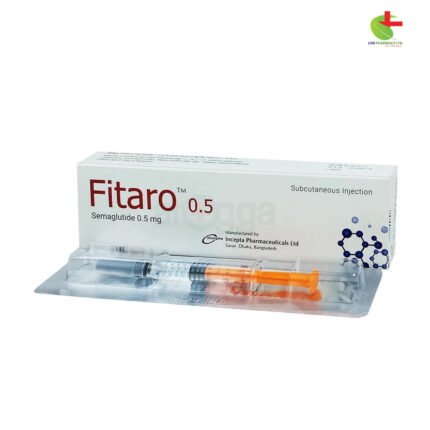

Orsema 0.50 Injection
600.00৳ Syringe(0.5mg)
- Orsema is a GLP-1 receptor agonist indicated for improving glycemic control in adults with type 2 diabetes and for chronic weight management in obese or overweight patients.
- It works by stimulating insulin secretion, lowering glucagon secretion, and reducing appetite, contributing to weight loss.
- Administered as a subcutaneous injection or oral tablet, Orsema requires careful monitoring for potential side effects, including gastrointestinal disorders.
- Caution is advised for patients with a history of pancreatitis, and it should not be used during pregnancy or breastfeeding.
 Brand
Brand
|
Incepta Pharmaceuticals Ltd |
|---|---|
 Generics
Generics
|
Semaglutide |
 Type
Type
|
SC Injection |
Indications
For Diabetes: Orsema is recommended for:
- Type 2 Diabetes Management: As an adjunct therapy to diet and exercise, it aids in improving glycemic control in adults diagnosed with type 2 diabetes mellitus.
- Cardiovascular Risk Reduction: It helps lower the risk of major adverse cardiovascular events in adults with type 2 diabetes who have established cardiovascular disease.
For Obesity: Orsema serves as an adjunct to a calorie-restricted diet and increased physical activity for managing chronic weight in adults with an initial Body Mass Index (BMI) of:
- Obesity: 30 kg/m² or higher.
- Overweight: 27 kg/m² or higher, accompanied by at least one weight-related comorbidity (e.g., hypertension, type 2 diabetes, or dyslipidemia).
Always use under the guidance of a registered healthcare professional.
Pharmacology
Semaglutide, a GLP-1 analogue with a 94% sequence identity to human GLP-1, acts as a selective agonist for the GLP-1 receptor. It lowers blood glucose levels in a glucose-dependent manner by enhancing insulin secretion and inhibiting glucagon secretion during hyperglycemia. Additionally, it slightly delays gastric emptying. In cases of hypoglycemia, Semaglutide reduces insulin secretion while maintaining glucagon levels. It also promotes weight loss and decreases body fat by suppressing appetite.
Dosage & Administration
For Diabetes:
Semaglutide Tablet: Administer Semaglutide at least 30 minutes prior to the first meal, beverage, or any other oral medication of the day, using no more than 4 ounces (118 ml) of plain water.
- Starter Dose: Initiate with 3 mg once daily for 30 days.
- Maintenance Dose: After 30 days on 3 mg, increase to 7 mg once daily.
- For Additional Glycemic Control: If further glycemic control is required after at least 30 days on the 7 mg dose, it may be increased to 14 mg once daily.
Semaglutide Injection: Start with a 0.25 mg dose once weekly. After 4 weeks, increase to 0.5 mg weekly. If additional glycemic control is necessary after at least 4 weeks on 0.5 mg, it can be raised to 1 mg weekly. Doses exceeding 1 mg weekly are not recommended. Semaglutide should be administered subcutaneously in the abdomen, thigh, or upper arm and can be taken any time of day, with or without meals. The injection site can be alternated without adjusting the dosage. Semaglutide is not to be given intravenously or intramuscularly. The day for weekly administration can be changed, provided there is a minimum gap of 3 days (>72 hours) between doses.
Transitioning between Semaglutide Injection and Tablet:
- Patients on 0.5 mg Semaglutide injection can switch to 7 mg or 14 mg Semaglutide tablets, starting up to 7 days after their last injection. There is no direct equivalent for transitioning from 1 mg injection to tablets.
- Patients taking 14 mg Semaglutide tablets may switch to 0.5 mg Semaglutide injections the day after their last tablet dose.
For Obesity: Initiate treatment with 0.25 mg Semaglutide via subcutaneous injection once weekly for 4 weeks. If dose escalation is not well-tolerated, consider delaying for another 4 weeks. If the 2.4 mg maintenance dose cannot be tolerated, a temporary reduction to 1.7 mg weekly is permissible for a maximum of 4 weeks before returning to 2.4 mg. Doses exceeding 2.4 mg weekly are not recommended. Semaglutide should be injected subcutaneously in the abdomen, thigh, or upper arm, similar to diabetes treatment.
Always use under the guidance of a registered healthcare professional.
Interactions
Orsema may slow gastric emptying, potentially affecting the absorption rate of concurrently administered oral medications. Caution is advised when using Orsema alongside drugs requiring rapid gastrointestinal absorption.
Contraindications
- Known hypersensitivity to the active ingredient or any excipients.
Side Effects
Patients may experience hypoglycemia, particularly when used in conjunction with insulin or sulfonylureas. Common adverse reactions include gastrointestinal issues such as nausea, diarrhea, vomiting, abdominal pain, and constipation. Typically, these effects are mild to moderate and resolve quickly. Other potential reactions include allergic responses, injection site reactions, lipodystrophy, pruritus, and rash.
Pregnancy & Lactation
Semaglutide is contraindicated during pregnancy. If a patient plans to conceive, discontinue Semaglutide at least 2 months prior to attempting pregnancy. Due to potential risks to breastfeeding infants, the use of Semaglutide during lactation is also not recommended.
Precautions & Warnings
- Diabetic Ketoacidosis: Orsema should not be used in patients with type 1 diabetes or for managing diabetic ketoacidosis.
- Pancreatitis: Discontinue use immediately if pancreatitis is suspected and do not resume if confirmed.
- Diabetic Retinopathy: Patients with diabetic retinopathy require careful monitoring.
Use in Special Populations
- Pediatrics: Safety and efficacy in children and adolescents under 18 years are not established, and no data is available.
- Elderly: No dosage adjustments are necessary based on age.
- Renal Impairment: No adjustments are needed for mild to severe renal impairment; however, it is not recommended for end-stage renal disease.
- Hepatic Impairment: No dosage adjustments are necessary, but caution is advised when prescribing Orsema.
Overdose Effects
Instances of overdose, including up to 4 mg in a single dose or weekly, have been documented in clinical studies, with nausea being the most commonly reported reaction. There is no specific antidote for Orsema overdose. Supportive treatment should be initiated based on the patient’s clinical signs and symptoms.
Dosage Adjustment
When adding Orsema to existing metformin and/or thiazolidinedione therapies, the current doses of those medications can remain unchanged. If combining with sulfonylureas or insulin, consider reducing their doses to mitigate hypoglycemia risk. Blood glucose self-monitoring is necessary for adjusting doses of sulfonylureas and insulin, especially when initiating Orsema.
Missed Dose
If a dose is missed, it should be taken as soon as possible within 5 days. If more than 5 days have elapsed, skip the missed dose and resume the regular dosing schedule.
Therapeutic Class
GLP-1 receptor agonists
Storage Conditions
Store at temperatures between 2 °C to 8 °C (refrigerated). Do not freeze. Keep out of reach of children.











Reviews
There are no reviews yet.